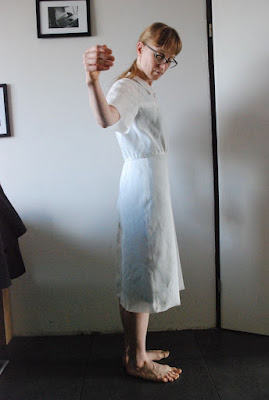The design I used as a starting point is the second one from this post. In many ways, it is the simplest one I tried and probably the least typical for the technique. But that also makes it the most likely one with which to get a wearable result for what is really still just me trying it out.
Most of the subtraction cut dresses you will find online have very simple, loose fitting sleeveless tops. I didn't really want that and I have cut the same bodice as the one I used for my recent dress. It will have buttons from the waist up and a side zipper.
Because I got the scale of the bodice wrong on the tiny dress, I didn't have quite as much length to cut holes for the skirt as it seemed in small scale. When I was marking the circles out for cutting, I realized that the bottom set on the front of the dress would end up too close to the hemline. So, I didn't cut those holes. (I'll make a proper pattern lay-out drawing when I post about the finished dress)
If you read about subtraction cutting, some people who tried it are very enthusiastic about how quick this technique is. If you read that, have a good look at the pictures. Many of those quick dresses are no more than muslins with raw edges at the armholes and neckline and over-long, unhemmed skirts spread on the floor. In my book, those are not finished dresses.
Making it a nicely finished dress doesn't require any special skills but it does mean constantly dealing with quite a lot of fabric around the sewing machine.
So far, I have put the bodice together but it still needs sleeves and a collar. I have also sewn up those holes.
The skirt doesn't have anywhere near the volume of that in the tiny dress (but a bit more than it seems on the dummy).
The strange thing I noticed when I tried it on was this:
The hole from the back is all the way down at my ankles. Deeply unpractical and it doesn't really do anything for the shape of the skirt. I tried connecting it to the top one at center front and that seems to work well. It creates that bustle-effect at the back which attracted me in the tiny dress (you can kind of see it in the side views but not really well enough. The lighting doesn't help. I'm sorry about that but I didn't have much time to take pictures)
The skirt is also too long. On the dummy, it almost looks like I could make that second set of holes after all but when I wore the dress, I really didn't think so. What I think I'll do is simply cut off about 40 cm at the bottom and then hem it. Unlike on the first dress I tried, the bottom edge of this one doesn't cross extra seams. That should mean I end up with a hi-low effect because the bustle hangs down to about the ankles. And the cut-off length will give me the extra fabric I need for the sleeves.
I'll keep you posted on the progress!



















































